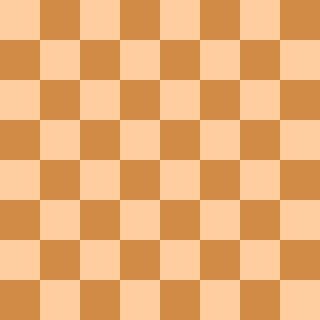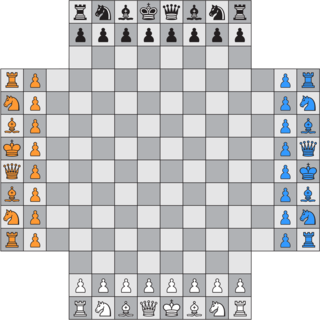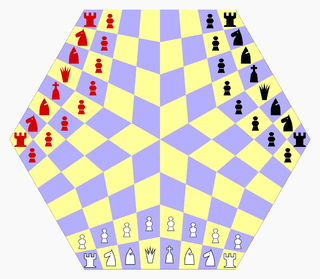
In chess, the king (♔,♚) is the most important piece. The object of the game is to threaten the opponent's king in such a way that escape is not possible (checkmate). If a player's king is threatened with capture, it is said to be in check, and the player must remove the threat of capture on the next move. If this cannot be done, the king is said to be in checkmate, resulting in a loss for that player. Although the king is the most important piece, it is usually the weakest piece in the game until a later phase, the endgame. Players cannot make any move that places their own king in check.

The rules of chess are rules governing the play of the game of chess. While the exact origins of chess are unclear, modern rules first took form during the Middle Ages. The rules continued to be slightly modified until the early 19th century, when they reached essentially their current form. The rules also varied somewhat from place to place. Today, the standard rules are set by FIDE, the international governing body for chess. Slight modifications are made by some national organizations for their own purposes. There are variations of the rules for fast chess, correspondence chess, online chess, and Chess960.
This page explains commonly used terms in chess in alphabetical order. Some of these have their own pages, like fork and pin. For a list of unorthodox chess pieces, see Fairy chess piece; for a list of terms specific to chess problems, see Glossary of chess problems; for a list of chess-related games, see List of chess variants.

Atomic chess is a chess variant. Standard rules of chess apply, but all captures result in an "explosion" through which all surrounding white and black pieces other than pawns are removed from play. Some variations additionally remove rules concerning check such that the king may be able to move into or remain in check.

Dark chess is a chess variant with incomplete information, similar to Kriegspiel. It was invented by Jens Bæk Nielsen and Torben Osted in 1989. A player does not see the entire board, only their own pieces and the squares that they can legally move to.
Makrukpronounced [màːk rúk]), or Thai chess, is a board game that descended from the 6th-century Indian game of chaturanga or a close relative thereof, and therefore related to chess. It is regarded as the most similar living game to this common ancestor of all chess variants.

Vernon Rylands Parton was an English chess enthusiast and prolific chess variant inventor, his most renowned variant being Alice Chess. Many of Parton's variants were inspired by the fictional characters and stories in the works of Lewis Carroll. Parton's formal education background, like Lewis Carroll's, was in mathematics. Parton's interests were wide and he was a great believer in Esperanto.

Tamerlane chess is a strategy board game related to chess and derived from chaturanga. It was developed in Persia during the reign of Timur, also called Tamerlane (1336–1405). Some sources attribute the game's invention to Timur, but this is by no means certain. Because Tamerlane chess is a larger variant of chaturanga, it is also called Shatranj Kamil or Shatranj Al-Kabir, as opposed to ash-shaghir. It is distinctive in that there are varieties of pawn, each of which promotes in its own way.

Four-player chess is a family of chess variants typically played with four people. A special board made of standard 8×8 squares with an additional 3 rows of 8 cells extending from each side is common. Four sets of differently colored pieces are needed to play these variants. Four-player chess follows the same basic rules as regular chess. There are many different rule variations; most variants, however, share the same board and similar piece setup.
Dice chess can refer to a number of chess variants in which dice are used to alter gameplay; specifically that the moves available to each player are determined by rolling a pair of ordinary six-sided dice. There are many different variations of this form of dice chess. One of them is described here.

Monochromatic chess is a chess variant with unknown origin. The initial board position and all rules are the same as in regular chess, except that pieces that begin on a black square must always stay on a black square and pieces that begin on a white square must always stay on a white square. This would mean that knights can never move, but The Classified Encyclopedia of Chess Variants says that knights make a double jump. It has been suggested that a knight be replaced with a (3,1)-leaper (camel).
Omega Chess is a commercial chess variant designed by Daniel MacDonald. The game is played on a 10×10 board with four extra squares, one added diagonally adjacent to the corner squares. The game is laid out like standard chess with the addition of a champion in each corner of the 10×10 board and a wizard in each new added square.

The following outline is provided as an overview of and topical guide to chess:

2000 A.D. is a chess variant created by V. R. Parton which employs fairy chess pieces on a 10×10 board. Parton published the variant in his 1972 monograph My Game for 2000 A.D. and After.

Wildebeest Chess is a chess variant created by R. Wayne Schmittberger in 1987. The Wildebeest board is 11×10 squares. Besides the standard chess pieces, each side has two camels and one wildebeest. The inventor's intent is "to balance the number of 'riders'—pieces that move along open lines—with the number of 'leapers'—pieces that jump".

Chad is a chess variant for two players created by Christian Freeling in 1979. It is played on an uncheckered 12×12 gameboard with one king and eight rooks per side, where rooks are able to promote to queens.

Dragonfly is a chess variant invented by Christian Freeling in 1983. There are no queens, and a captured bishop, knight, or rook becomes the property of the capturer, who may play it as his own on a turn to any open square. The board is 7×7 squares, or alternatively a 61-cell hexagon with two additional pawns per side.

Three-Man Chess is a chess variant for three players invented by George R. Dekle, Sr. in 1984. The game is played on a hexagonal board comprising 96 quadrilateral cells. Each player controls a standard army of chess pieces.


















